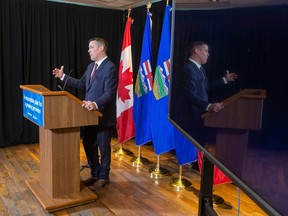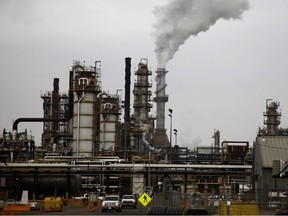We’re not getting off the treadmill of spending non-renewable resource revenue any time soon without a sharp course correction

Article content
The UCP government has big plans to stash money in the Heritage Fund and get Alberta off its chronic reliance on resource revenue, yet there are some inescapable truths in its new budget.
Alberta will see record oil production this year.
Article content
It expects to collect $17.3 billion in resource revenue, almost 25 per cent of all government revenues.
And the province will need virtually every penny to pay for government spending in the coming year.
Advertisement 2
Article content
We’re not getting off the treadmill of spending non-renewable resource revenue any time soon without a sharp course correction.
On Thursday, Finance Minister Nate Horner released the province’s new $73-billion budget, showing a tiny $367-million surplus in the coming year.
It’s followed by skinny surpluses of $1.4 billion and $2.6 billion in the following years.
There is little wiggle room to stay in the black if oil and gas prices take a tumble or the economy decelerates.
Last week, Premier Danielle Smith vowed to wean the province off “the volatile roller-coaster of resource revenues.”
The new budget doesn’t spell out how that’s possible.
However, Horner said the government will establish a long-term road map by year’s end on how it can grow the Alberta Heritage Savings Trust Fund by at least 10-fold by 2050.
“We think it’s entirely possible to grow that fund to $250 billion to $400 billion over a couple of decades,” Horner said in an interview.
“It’s not a number we made up. We had an outside firm do a deep dive, (they’ve) done a lot of work with other sovereign wealth funds and that’s the number they came back with as being realistic.”
Article content
Advertisement 3
Article content
It would require a lot of heavy lifting, even with some initial steps taken over the past year.
Recommended from Editorial
-
Alberta Budget 2024: Read our full coverage here
-

Alberta Budget 2024: Slim $367 million surplus projected as revenues decline
-

Alberta Budget 2024: What you need to know
-

Alberta Budget 2024: Alberta is Calling, again — province wants more skilled workers to close labour gap
-

Alberta Budget 2024: Province to introduce $200 annual electric vehicle tax
-

Braid: The budget stalls tax relief, reveals hard cash paid to end lab test fiasco
-

Alberta Budget 2024: Provincial spending fall short of city’s expectations
-

Alberta Budget 2024: $2 billion set aside for potential disasters amid flood, drought and wildfire threats
-

Alberta Budget 2024: Cost of restructuring AHS pegged at $85 million over next two years
-

Alberta Budget 2024: Province to spend more on staff at K-12 schools
With a $5.2-billion budget surplus forecast in the outgoing 2023-24 year that ends next month, the province intends to deposit an additional $2 billion into the fund.
It will also continue letting the fund retain its investment income, instead of putting it into general government revenues for spending.
Advertisement 4
Article content
That decision follows a $753-million deposit in the current budget year, the first time such a deposit has occurred in more than 15 years.
By the end of 2025-26, the fund is projected to grow to $25 billion in value.
“These oil and gas revenues that we get right now will not be around forever, they will decrease at some point,” said Mike Holden, chief economist of the Business Council of Alberta.
“Once the royalties are gone, they’re gone, and we need something to replace them. What the Heritage Fund does is take some of our surplus revenue and create an interest stream that will last forever. And that’s the goal we’re trying to achieve.”
It’s been an elusive goal.
The Heritage Fund was created by the Lougheed government 48 years ago. For a few years in the 1980s, the province stashed 30 per cent of all resource revenue into the account, until oil prices tanked.
Since then, only $6 billion of investment income has been kept in the fund.
Norway’s sovereign wealth fund, established in the 1990s, holds more than US$1.6 trillion of assets today.

Horner said the biggest part of expanding the fund to $250 billion in value by 2050 would mean leaving the retained investment income within the fund, while noting other sovereign wealth funds also have a different composition and contain a large private equity component.
Advertisement 5
Article content
“We started this before Norway. They all copied us. They just left the retained earnings in and stuck to the plan,” he added.
“No other province has the sort of the ability to do this. And if we can really let it grow, then down the road, hopefully for my grandkids, they’ll be able to still enjoy some of the tax advantage that we can give Albertans today.”
To grow the fund to $400 billion would likely mean putting aside some resource revenue each year. Right now, that money is used to help finance government spending, such as for health care and education.
“We have a large structural deficit outside of oil and gas and bitumen royalties,” added Horner. “There’s very few options if you need to replace that kind of revenue.”
On the energy front, the province is projecting benchmark U.S. oil prices to average US$74 a barrel — about $4 a barrel below prices on Thursday — and stay at that level for the two following years.
Alberta has been ramping up production from the oilsands this decade, posting records last year.
The province forecasts oil output to average almost 3.9 million barrels per day (bpd) this year, up 100,000 barrels from last year’s levels, and averaging 4.3 million bpd by 2027.
Advertisement 6
Article content
Royalty revenues will remain relatively high and exceed $17 billion this year, but down $2.1 billion from last year’s level, due to lower commodity prices.
“Energy prices put Alberta on a roller-coaster,” said Douglas Offerman, an analyst with Fitch Ratings.
“The ability to support the budget over time — and to meet the longer-term goals with the Heritage Fund — in some respect are going to depend on what energy prices look like over time.”

It won’t be easy to get off the resource roller-coaster where almost all of the oil and gas royalties are spent, but it can be done by growing savings over time, said Alberta Central chief economist Charles St-Arnaud.
By his estimates, the province would need to inject about $3.7 billion of resource revenues each year into the fund to grow it large enough to replace all resource revenues with an income stream by 2050.
“Better now than never,” he said.
University of Calgary economist Trevor Tombe said that even if the province simply left the investment income in the fund, it would increase to about $175 billion by 2050.
“They’re absolutely increasing the Heritage Fund gradually over time,” he added.
“But in this budget, they presented nothing that would ease the province’s reliance on volatile resource revenues. This budget increases our reliance on volatile resource revenues.”
Chris Varcoe is a Calgary Herald columnist.
Article content










